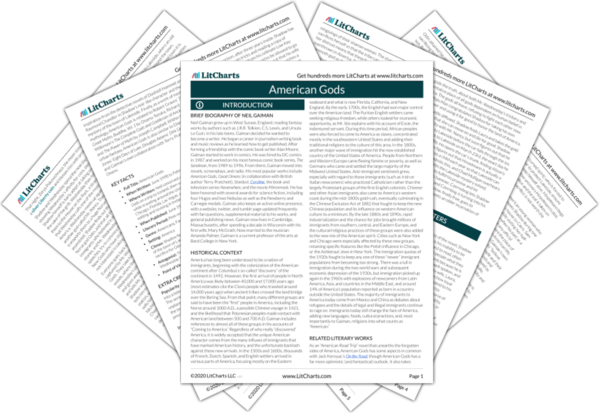Mythology, Belief, and Community
American Gods aims to show that mythology is not a primitive belief system relegated to unsophisticated cultures. For Gaiman, the same questions, desires, and superstitions that led humans to create Odin and the other Old Gods are still embedded in the human psyche, causing contemporary people to worship material things and cultural phenomena in the same way the ancients worshipped their gods. By reframing contemporary cultural phenomena as semi-religious myths created to fulfill the human…
read analysis of Mythology, Belief, and CommunityChange and Growth
Americans, who come from a country that is relatively new (globally speaking), are known for constantly looking to the future rather than reflecting on the past. This focus on the future creates a culture of fast-paced change that the gods, since they derive power from peoples’ belief in them, must navigate in order to remain relevant to Americans. The novel shows many possible fates that the gods can suffer at the hands of time. Some…
read analysis of Change and GrowthLife, Death, Desire, and Sacrifice
In American Gods, life and death are two sides of the same coin; each is meaningless without the other. Gaiman explores this interdependence through the relationship of life and death with fear and desire. Those who accept that death is an inevitable part of life are better able to enjoy their lives, and those who fear death tend to be unable to live fully—in particular, they are shown have a difficult relationship to their…
read analysis of Life, Death, Desire, and Sacrifice
Deception
Deception and lies follow all the characters throughout their journeys in American Gods,. This trickery may be profitable in the short term, but Gaiman shows that deception will never help a person achieve long lasting success. This suggests that, though Gaiman sees deception as an inescapable part of human life, he nonetheless sees an unimpeachable value in fighting for truth. Most people (and gods) live their entire lives in a state of deception; the…
read analysis of DeceptionPlurality and the Power of the Individual in America
America—a relatively young nation composed largely of immigrants—is, in some sense, defined by its lack of definition: Gaiman writes that America is “the only country that does not know what it is.” As a country, the United States does not have a long history from which to draw its identity, and it does not have a single religion, language, culture, or heritage that can encompass or define it. In addition, the country is constantly changing…
read analysis of Plurality and the Power of the Individual in AmericaThe Sacredness of American Land
While Gaiman sees plurality and change as the central characteristics of America, he does suggest that one part of America is constant and unimpeachably sacred: the land itself. The land, for Gaiman, is the literal and spiritual foundation of all that America is, as its resources anchor the country and make all of its advancement and achievement possible. While the gods are flamboyant presences in American life and human individuals are also worshipped like gods…
read analysis of The Sacredness of American Land











